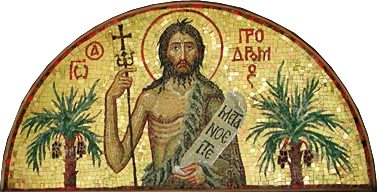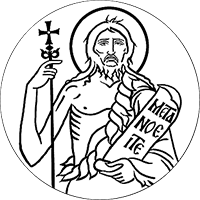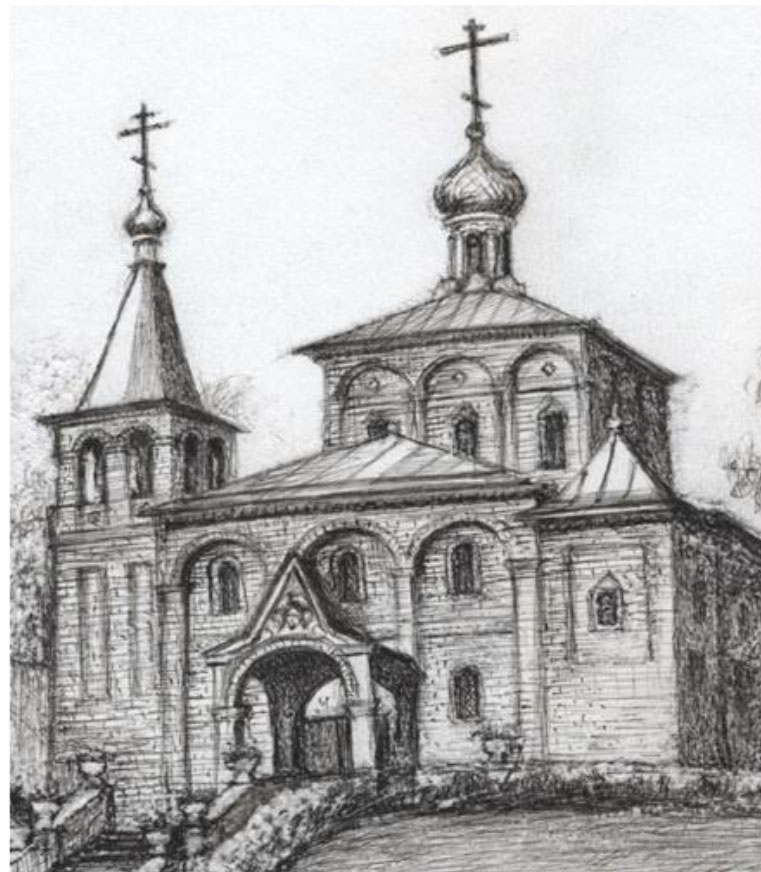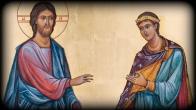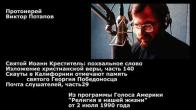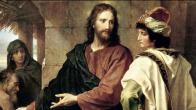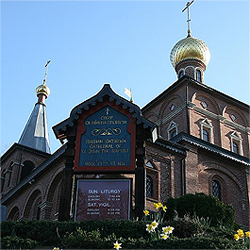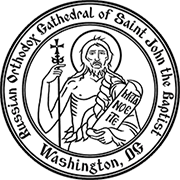You are here
September
- August 19/September 1 -- "Of the Don"
- September 1/14 -- "Chernigov-Gethsemane" , Icon of Miasena Monastery
- September 3/16 -- "Pisidia"
- September 8/21 -- "Pochaev", "Kholmsk"
- September 9/22 -- "Isaakovskaya-Poshekhonskaya"
- September 14/27 -- "Lesna" Icon
"Of the Don" Icon
19 August/1 September
This holy icon is historically linked to one of the most important moments of the formation of the Russian state - the gathering together of Russian lands around a single and hereditary grand-princely/royal authority. The widespread veneration of the miraculous Don icon of the Mother of God is tied to the victory, on Kulikovo Field, of Prince Dimitry Donskoy over the Tatars. The army carried this image as a banner during the battle, which took place on 8 September, the feast of the Nativity of the Most Holy Theotokos, in the year 1380. After the victory, the icon was given as a gift by the Don Cossacks to Great-Prince Dimitry Donskoy (1363-1389), who brought it to Moscow.
In 1591, while a battle with the Crimean Tatars was taking place on the very threshold of Moscow itself, many tears were shed and prayers offered before the Don image of the Mother of God. The preservation of the Russian capital was attributed to her, and in commemoration thereof, the Donskoy Monastery was erected on the site in Moscow on which the icon had stood during the battle. After this victory, the miraculous icon remained in Moscow, at first in the Dormition Cathedral in the Kremlin, and later in the Annunciation Cathedral.
On the Don icon is the image of the Mother of God, thought to have been written by the famous iconographer Theophanes the Greek. On the reverse side is depicted the Dormition of the Mother of God. From the standpoint of iconography, this is a very well pre-served 14th century example of the "Tenderness" icon. The Mother of God bows her head towards the Infant, Who is seated on her right arm and supported by her right hand. The Divine Infant's legs are bare up to the knees. The icon expresses feelings of joy, calm and tenderness, together producing an altogether unique effect. In the icon can be see the beginnings of the new Russian iconographic tradition of the 14th century.
"Chernigov-Gethsemane" Icon
1/14 September
The Chernigov-Gethsemane Icon of the Mother of God is a copy of the renowned Chernigov-Ilinsk Icon of the Theotokos which was in the Holy Trinity-St Elias Monastery on Boldyna hill near Chernigov, a monastery in which St. Anthony of the Kiev Caves had spent some time in spiritual struggle. In The Bedewed Fleece, Holy Hierarch Dimitry of Rostov related the miracles which began to flow from the Icon 16/24 April 1662.
He concluded his account with the words, “The end of this book, but not of the miracles of the Most-holy Theotokos, for who can recount their number?” This Icon’s grace-filled power was also manifested in copies made from it.
The Chernigov-Gethsemane Icon of the Mother of God was written on canvas in the 18th century. It was transferred in 1852 to the Holy Trinity-St. Sergius Lavra by Alexandra Grigorievna Philippova, who had piously cared for it for a quarter of a century.
The Icon had been given to her as a blessing from Fr. John Alexeev, a priest from the town of Khodkov; he in turn had received the Icon from one of the monks of the Holy Trinity-St. Sergius Lavra. Upon the advice of Archimandrite Anthony ( +1 May 1877), administrator of the Lavra, the Icon was placed in the newly erected cave church of St. Michael the Archangel, consecrated on October 27, 1851 by Metropolitan Philaret of Moscow (+19 November 1867), who also played an active role in the building of the Gethsemane Skete.
The Icon was nourished by the streams of grace flowing through the entire history of the Russian church; it acquired the blessing of Venerable St. Anthony of the Caves, of Venerable St. Sergius of Radonezh, his parents Schemamonk Kirill and Maria (+1337; a Requiem Liturgy with a special prayer is celebrated for them on September 28th and on Thursday of the Week of the Publican and the Pharisee), and finally, of the strugglers of the 19th century. These spiritual ties were providentially revealed through the Chernigov-Gethsemane Icon of the Mother of God.
It is noteworthy that the first miracle from this Icon was witnessed on the Liturgical New Year, September 1, 1869, when Thecla Adrianova, a 28 year-old peasant of Tula Province, was healed of the total paralysis which had afflicted her for 9 years. Thecla lived first in a hostel attached to the Caves, and then in the Lavra itself, until September 25th, the day marking the repose of St. Sergius; then she was completely healed. Holy Hierarch Innocent Metropolitan of Moscow (1797-1879, commemorated September 23 and March 31), learned of the miracle from his daughter the nun Polixenia, treasurer of the St. Boris Hermitage. On the Feast of Venerable St. Sergius, he met Thecla and questioned her about all of the details of her healing. On September 26, 1869, St. Innocent visited the Gethemane Skete, gave his blessing to the offering of prayers before the glorified Icon, and there himself offered tearful prayers.
Before September 26th, there were three other miraculous healings; many others followed in November of the same year. Word of the Icon of the Mother of God spread with extraordinary speed. People of all different classes, people tortured with suffering and diseases, thirsting for bodily and spiritual healing, and strong in faith, came to the Miraculous Icon. God’s mercy did not abandon them. By the beginning of the 20th century, more than 100 miracles had been documented. At first, the Icon’s Feastday was set as April 16th, the date on which the Chernigov-Ilinsk Icon was commemorated. However, it was later transferred to September 1st, the day of its glorification. Currently, there are miraculous copies of the Chernigov-Gethsemane Icon, written by elders of the Gethsemane Skete and the Zosima Hermitage, in the Holy-Trinity -St. Sergius Lavra; in the church of St. Sergius, in the monastery refectory; and in the narthex of the Holy Trinity Cathedral.
The Miasenskaya (Azurovskaya) Icon
1 / 14 September
The Icon of the Mother of God known as the Miasenskaya Icon is in the Miasena Monastery. The following is an account of how the monastery came to be and how its Icon of the Mother of God came to be glorified.
Not far from the Armenian town of Melitine, founded by Roman Emperor Trajan (98-117AD), there stood the beautiful Miasena plain, surrounded by high hills that protected it from strong winds. The beauty of that valley was crowned by the small but clean and quick-running Azoros, or Azur, River. With its waters moving East across the area, the river formed a number beautiful lakes whose banks were covered with lush vegetation.
During the early centuries of Christian history, pagans densely populated the Miasena plain. In the shade of a thick grove of trees on the bank of one of the lakes, there stood a pagan temple. In the 4th Century, Christianity was declared the state religion, and paganism began to weaken, giving way to the new religion; by the beginning of the 5th Century, pagan settlements were reduced to pathetic remnants that would soon completely disappear from the face of the earth. By order of the Christian government authorities, pagan temples were to be destroyed and Christian churches erected in their place. To keep some measure of freedom to offer services to their gods, pagans had to hide in isolated, remote places in the wilderness. However, gradually Christianity and became victorious over pagan darkness everywhere. This was so in the case of the Miasina pagan temple as well. St. Akakios, Bishop of Melitine, (commemorated April 17 and September 15) wanted to build a church dedicated to the Most-holy Theotokos on the site of the Miasena temple. The pagans could not openly oppose the bishop’s efforts, but they secretly resorted to all manner of trickery to impede the work – e.g. at night, undoing all of the work done by Christian laborers during the day. Nonetheless, the energetic bishop completed the construction, and with great solemnity, consecrated the newly-erected church. Thus, in the words of the author of St. Akakios’ vita, “in the same place where evil bloody sacrifices had been made to the devil, there [they] began to offer to God the bloodless, pure sacrifice, and there were worked miracles through the grace of the Most-holy Mother of God.”
Later, a monastery, also known as Miasena, appeared near that church. The Monastery’s most important holy treasure was its Miraculous Icon of the Most-holy Theotokos. No account of who wrote that icon, or when it was written, has survived. As to its later history and glorification, tradition tells us that when the iconoclast heresy appeared in the East during the reign of Emperor Leo Isaurius (716—741), local iconoclast authorities ordered the Miasena Icon of the Mother of God to be thrown in the lake. During the reign of Michael III (842—867) the iconoclast heresy came to an end, and true veneration of icons was reinstituted. Then, from the depths of the lake in which it had rested for over a century, the Miasena Icon rose to the surface and was retrieved, completely unharmed, by the faithful. September 1 was established as the Feastday to commemorate the finding of the Icon on September 1, 864; it is known as the “Synaxis of the Most Holy Theotokos in Miasena Monastery,” i.e. the gathering of the faithful to venerate the Miraculous Icon of the Mother of God.
The Pisidia Icon of the Mother of God gained renown in the city of Sozopolis as a miraculous Icon. Its origin is unknown. In an epistle regarding veneration of icons, read at the 7th Ecumenical Council, Germanus, Patriarch of Constantinople referred to “the icon of the Most-immaculate Virgin Theotokos, found in Sozopolis of Pisidia, and streaming myrrh from the depiction of the arm,” as “ancient.” Miracles attributed to it took place in the 6th Century. The presbyter Eustatius, a contemporary of Patriarch Eutychius (commemorated 6th April) recorded an account of one of the miracles. In Amasia, near Sozopolis, there was a married couple whose children were all stillborn. In grief over their misfortunes, they turned to Eutychius for advice. St. Eutychius prayed, and with the words “In the Name of our Lord Jesus Christ” anointed them with oil from the Cross of our Lord and from the Holy Icon of the Theotokos. He said, “Name the child Peter, and he shall live.” Soon, they had a son, whom they named Peter, and later they had another son, whom they named John. Upon hearing of this miracle, the city residents glorified God. Myrrh continued to stream from the Pisidia Icon of the Mother of God for 600 years. One eyewitness was Eleusius, disciple of Venerable St. Theodore Sayosota (commemorated 22 April). A copy of this ancient miraculous Icon was made in 1608 in the Novospassky Monastery in Moscow. The Mother of God is depicted holding the Divine Infant in her left arm, while her right arm is extended in blessing.
"Pochaev" Icon
23 July / 5 August; September 8/21
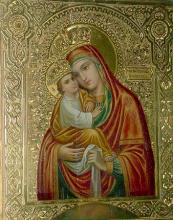 The Pochaev Dormition Lavra is one of four lavras in the Russian Empire. It is a bastion of Orthodoxy inИкона Божией Матери Почаевская South-western Rus’, in Volhyn (now part of Ukraine’s Ternopol Province). This is a place where throughout the ages, borders between empires, civilizations, and world views clashed. Until 1914, the Austro-Hungarian border was a mere 8 versts [1 verst = 1.07 km.] away, and the fame of Pochaev’s holy objects extended not only to neighboring Galicia, but also to Bulgaria, Bosnia, and Serbia.
The Pochaev Dormition Lavra is one of four lavras in the Russian Empire. It is a bastion of Orthodoxy inИкона Божией Матери Почаевская South-western Rus’, in Volhyn (now part of Ukraine’s Ternopol Province). This is a place where throughout the ages, borders between empires, civilizations, and world views clashed. Until 1914, the Austro-Hungarian border was a mere 8 versts [1 verst = 1.07 km.] away, and the fame of Pochaev’s holy objects extended not only to neighboring Galicia, but also to Bulgaria, Bosnia, and Serbia.
At one time, this had been a forest-covered hill, where monks carried on their spiritual struggle living in caves. They were hermits from the Kiev Caves who had taken refuge here after the mother of all Russian cities Kiev was laid waste in 1240 by Baty [Khan].
In that same 13th Century, two of the nameless strugglers, along with the local shepherd Ivan the Barefoot, were made worthy to witness a great miracle: the appearance of the Most Pure One in a pillar of fire standing above the Pochaev hillside. In the solid limestone on which the Theotokos had been standing in prayer that night, there remained the print of her right foot; that footprint is the most ancient of the holy treasures of Pochaev. The footprint is always full of pure healing water from a spring that burst forth on that same night.
At the base of the hill, the monks soon erected the first stone church, in honor of the Dormition. Now the enormous Dormition Cathedral, built in the 1780s in the baroque style, and encompassing the hill itself, the caves, the Footprint, and the sacred spring, stands on the site. Rising like a cliffside set amid the boundless surrounding fields, the cathedral is visible many kilometers from the town of Pochaev itself.
However, back in the 13th Century, with the collapse of Rus’ and the gradual falling away of its Southwestern lands, the monastery fell into decline as well.
The monastery was re-established at the turn of the 16th Century. In 1559 the Greek Metropolitan Neophyte, who was traveling through the area stopped for the night at the home of the pious landowner Anna Goiskaya. In thanks for her cordial hospitality, he left the housewife a memento: an image of the Theotokos painted in Constantinople.
For three decades, the icon remained in the house chapel in the village of Urlya (about 8 versts from Pochaev). Then it began to emit a mystical radiance at night, a radiance like unto the pillar of fire in which 300 years earlier, the Most-holy One herself had appeared there. Philipp Kozinsky, who was the brother of the lady of the house and who had been blind from birth, regained his sight before that Icon. The Goisky family interpreted the miracle as a Queen of Heaven’s expression of her intention to abide in the restored Pochaev Monastery, to which they gave the Icon, along with generous gifts.
After Anna’s death in 1644, all of the surrounding lands were inherited by one of her kinsmen who hated Orthodoxy, and who robbed the Monastery and seized the Icon. However, he and his wife were immediately visited with a brutal sickness from which they recovered only after they had returned the Miraculous Icon to the Monastery.
Since that time the Miraculous Icon has been housed in a frame in the shape of a radiant star, in the third row of the Dormition Cathedral iconostasis. On special occasions, it is lowered down from its place so that pilgrims might venerate it. The "Pochaev" Icon has gained renown for a host of miracles.
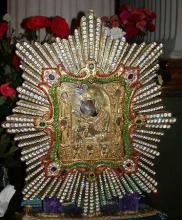 The "Pochaev" Icon is of the type known as the Eleoussa Icon. The Pre-eternal Infant sits on her rightПочаевская икона Божией Матери arm. In her left is a cloth partially covering the Son of God. Usually, on copies of the Miraculous Icon, the Footprint of the Theotokos is also depicted below her image.
The "Pochaev" Icon is of the type known as the Eleoussa Icon. The Pre-eternal Infant sits on her rightПочаевская икона Божией Матери arm. In her left is a cloth partially covering the Son of God. Usually, on copies of the Miraculous Icon, the Footprint of the Theotokos is also depicted below her image.
Through the intercession of the Most-holy One, the Monastery remained faithful to Orthodox even under Polish-Lithuanian rule, resolutely opposing the Uniate assaults upon the area.
The Theotokos also manifested her marvelous help during the siege of the Monastery by the Turks in the year 1675, when the Hagarites completely surrounded the Monastery’s wooden structures and threatened to put them to the torch. The Monks appealed to the Image of our Sovereign Lady with prayers that she intercedes.
Then the Turks witnessed an awesome sight in the sky above the Cathedral: The Most-pure One hovered above her Monastery in radiant splendor, surrounded by the Angelic Hosts armed with flaming swords, and extending her Omophorion over the Monastery. Next to the Sovereign Lady stood Venerable St. Job, the recently deceased (+ 1651) Abbot of Pochaev, who prayed along with his earthly brethren for her assistance.
Blinded by the heavenly apparition, the Hagarites turned on one another, and fled from the site which had so terrified them.
Despite its firm resolve to remain Orthodox, in 1713 the Pochaev Monastery was forcibly turned over to the Uniates, and remained under them until the Polish rebellion of 1831. Returned to the bosom of Orthodoxy, in 1833 the Monastery was granted the great honor of being called a Lavra, and ranked as “fourth among the Lavras in Russia” (along with the Kiev Caves, Holy Trinity-St. Sergius, and Alexander Nevsky Lavras).
In Moscow, there is a greatly venerated "Pochaev" Icon in the Lefortovo Church of Sts. Peter and Paul. This church was never closed down, and here the Icon was brought at the height of atheist persecutions of the 1930s.
Kholmsk Icon
8/21 September
Its origin is in antiquity. According to local tradition recorded by Bishop James Sushey, it was written by the Holy Evangelist St. Luke, and brought to Kievan Rus' during the reign of Prince Vladimir, who received a multitude of icons from Constantinople after he underwent Holy Baptism.
Kholmsk Icon is written on three linked cypress panels. In ancient times, the Icon was enhanced by an expensive riza of Byzantine craftsmanship, cast in gold and covered with enamel. However, 1261, at the time of the Tatar invasion, Burunday's forces came to South-Western Rus' and sacked the town of Kholm (the town today known as Chelm, in the Republic of Poland), where the Holy Icon was. The Icon itself suffered at their hands: in removing the riza from the Icon, they damaged the image in several spots, and the Icon itself was lost. It was during excavations one hundred years after the destruction of Kholm that the Holy Icon was found and installed in the reconstructed Kholm Cathedral. In our days, two wounds inflicted upon the Icon by the Tatars are visible: one, which was caused by a saber stroke, is on the left shoulder; another, caused by an arrow, is on the right arm. According to pious tradition, immediate punishment was meted out to the impious Tatars who were looting the Church: they lost their eyesight.
When in 1596, Dionysiy Zbiruisky, Bishop of Kholm, joined the Unia, the Kholm Cathedral and the Icon fell into the hands of the Uniates. In 1650, during the Cossack uprising under Bohdan Khmelnitsky in Ukraine, the Uniates were forced, under the terms of the Zborovsk Treaty, to return the Icon to the Orthodox Bishop, Dionisiy Balaban. At the same time, the Uniates attempted to hide the Icon. Thus, it was some time later that it was found in a dungeon. In 1651, war broke out with renewed force, and the Icon once again fell into Polish hands. On the advice of James Sushiy, King Jan II Casimir took the Kholm Icon with him into battle, and subsequently displayed it in Warsaw in the chapel of the royal palace, where it remained until 1652. Jan Casimir attributed his victory over the Cossacks to the Mother of God, whose Kholm Icon was with him during the military campaign. In thanks, the king restored the Uniate diocesan seat to Kholm, and turned the Icon over to that diocese. On April 29, 1652, it was installed in the cathedral in Kholm. Meanwhile, war between Poland and Ukraine once again erupted with greater intensity. The king once again took the Miraculous Kholm Icon onto the field of battle, but It did not render him any assistance. The Polish army suffered a defeat, after which the Kholm Icon was returned to the Kholm Cathedral, where it remained until the early 20th Century.
Under Uniate rule, attempts were made to Latinize the Miraculous Icon and the Kholm Cathedral itself. In accordance with Catholic custom, the Icon was placed above the main Altar Table in the Altar. In 1765 the Roman Pope crowned the Icon with two gold crowns. A silver tablet bearing a bas-relief and an inscription in Latin was affixed to the front of the Altar Table above which the Icon hung; today it is kept in the Moscow Armory in the Kremlin.
Kholmsk Icon and the Cathedral were returned to an Orthodox community in the first half of the 19th Century. The Holy Icon was officially installed above the Royal Doors of the Icon Screen.
Archimandrite Ioannikios Golyatovsky's book The New Heaven relates accounts of the many miracles that took place before the that Icon.
During the Tatar attacks in the time of Batu Khan some of his forces set out for Kholm. At that time, in the town there lived two pious princesses. Seeing that defense by force of arms was impossible, they, together with others, turned in prayer to the Theotokos before her Kholmsk Icon, and implored her to take the town under her protection. Then the women took the Miraculous Icon from the Church and placed it on the fortress wall facing the enemy forces. Some kind of obsessive delusion was visited upon the Tatar forces: the hill upon the town rested began to appear to be much higher and steeper than it really was. The closer they approached, the more powerful was that sensation. Seized with panic, they began to retreat. Thus, through miraculous help from the Theotokos, the town was saved.
Currently, Kholmsk Icon of the Theotokos is on display in the Volhyn Iconography Museum in the town of Lutsk.
"Isaakovskaya-Poshekhonskaya" Icon
9 / 22 September
The miraculous icon of the Mother of God known as the Isaakovskaya Icon, was housed in the men’s monastery in the Yaroslavl province, Poshekhonye district. This monastery was named after the town of Isaakovo, on whose territory the holy icon appeared.
On November 25, 1659, some local residents were in the forest, and saw resting in the branches of a yew tree, an icon of the Nativity of the Most-holy Theotokos, from which there burst forth a radiant light. They immediately sought to take the icon and to bring it to their town, but during that attempt they were seized by a horror from which, according to the chronicler, "Their spirits quaked, their bones and sinews shook, and they were as if struck numb." Then the peasants ran to their priest and told him and the populace what had transpired. The priest put on his vestments, and accompanied by the clergy and by people carrying khorugvy (church banners), they went out to the place, about one kilometer from town, where the icon of the Mother of God had appeared. Then all saw the unusual light, shining from the branches of the yew tree like the sun, and within that light, the icon. After singing a moleben, the priest piously removed the icon from the tree, and with it, returned in solemn procession to the town of Isaakovo. Installing the icon in the parish church, he again served a prayer service, and in the evening, after the people had left, locked up the church. The next day, when everyone returned to the church for Matins, all were struck with amazement, for although all of the windows and doors were still securely locked and bolted, the newly discovered icon was not in the church. Some of the people ran to the place in the forest where the icon had appeared, and soon returned to relate that the icon was in that same tree. The priest again set off on a procession of the cross into the forest to the icon, and reverently transferred it to the church. The news of the miracles connected with the newly discovered icon quickly spread, and multitudes of people came from all directions to venerate the icon of the Most-holy Theotokos. Towards evening, the doors of the church were locked, and a guard was set, but the next morning, by an unseen power, the icon was again translated into the forest to the place of its discovery. Then all realized that it was the will of the Queen of Heaven that this holy icon remain there at the place she had chosen. The people’s determination was so strong that in a single day, they built a chapel on the site, and on the following day consecrated it, and with appropriate solemnity transferred the icon there.
From that time on, great miracles came forth from the Icon, and crowds of faithful ran to her. The Elder Ephraim was assigned to be the first warden of the chapel, and through his pious life, turned towards prayer the hearts of those who visited. Gradually, a small skete developed near the chapel. Through the petitions of elder Ephraim, Jonah, Metropolitan of Rostov and Yaroslavl’ permitted the replacement of the chapel with a wooden church, and next to it a monastery.
In 1750, the wooden church burned down to its foundation. In 1758, a stone church replaced the wooden one, and was dedicated to the Nativity of the Most-holy Theotokos, with a chapel to the Holy Hierarch and Miracle-worker St. Nicholas. To the left of the Royal Doors of the iconostasis was the holy treasure of the monastery, the miraculous icon of the Most-holy Theotokos, with an oil-lamp continuously burning before it.
PARISH LIFE
RECENT VIDEOS
Address of our Cathedral
Subscribe to our mailing list
While all the materials on this site are copyrighted, you may use them freely as long as you treat them
with respect and provide attribution on the Russian Orthodox Cathedral of St.John the Baptist of Washington DC.
